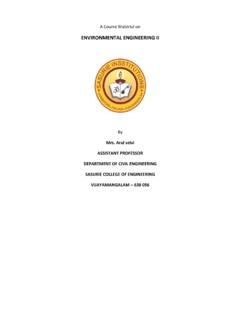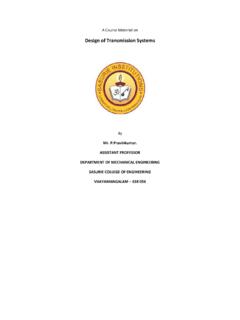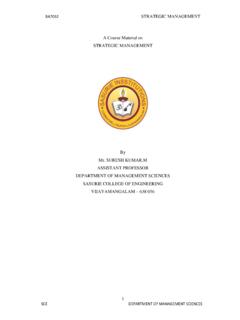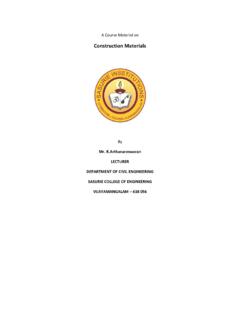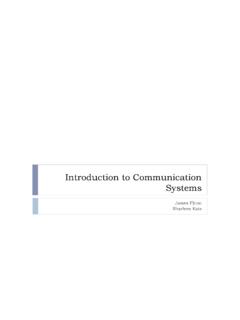Transcription of A Course Material on SATELLITE COMMUNICATION
1 A Course Material onSATELLITE COMMUNICATIONByMr. C. Sundar RasuASSISTANT PROFESSORDEPARTMENT OF ELECTRONICS & COMMUNICATIONENGINEERINGSASURIE COLLEGE OF ENGINEERINGVIJAYAMANGALAM 638 056 QUALITY CERTIFICATEThis is to certify that the e- Course materialSubject Code:EC2045 Subject: SATELLITE COMMUNICATIONB eing prepared by me and it meets the knowledge requirement of the of the AuthorName:C. Sundar RasuDesignation:Assistant ProfessorThis is to certify that the Course Material being prepared by Sundar Rasuis ofadequate quality. He has referred more than five books among them minimum one isfrom abroad : IV Year E1 Introduction to SATELLITE s s law s First s Second Law s 's first 's second 's first Effects of non-Spherical Atmospheric stationary and Non Geo-stationary Geo Non Geo-Stationary Angle of SATELLITE Orbit vehicles and Transfer Orbit.
2 UNIT IISPACE SEGMENT & SATELLITE LINK Technology- Control & Orbit p i n n i n gsatellite wheel wideband input power uplink and downlink Analysis and Isotropic LossesUNIT ISATELLITE Controland Payload & Support Link-Power Budget noise modulation Characteristics and Frequency Radio reliability and design System lifetime:UNIT IIISATELLITE and Multiplexing: Voice, Data, Voice, Data, Modulation And digital transmission Analog vs. digital Data/Analog Video Broadcasting (DVB) Access Frequency division duplexing (FDD) Time division duplexing (TDD) Code Division Multiple Access(CDMA) allocation DCA and Spread spectrum Encryption and Video and MPEG Standards :67 UNIT IVEARTH Station terrestrial Transmitter and Earth Station Tracking Systems Feed Antenna Reflector Antenna Antenna Tracking System HomeTV Indoor outdoor AntennaTV AntennaTV Equipment Measurements on G/T, C/No, Gain.
3 89 UNIT VSATELLITE INSAT Satellites In SATELLITE Global Positioning System (GPS) Navigational Broadcast satellites (DBS) Power Rating and Number Bit Ratesfor to home Broadcast (DTH) DTH Block audio broadcast (DAB) Television (BTV)-Adaptations for Conferencing (medium resolution) Internet access:Two Marks Question & Answers118 Important Question Bank132EC2045 SATELLITE COMMUNICATIONAIMTo enable the student to become familiar with satellites and SATELLITE Overview of SATELLITE systems in relation to other terrestrial systems. Study of SATELLITE orbits and launching. Studyof earth segment and space segment components Study of SATELLITE access by various users.
4 Study of DTH and compression I SATELLITE ORBITS8 Kepler s Laws, Newton s law, orbital parameters, orbital perturbations, station keeping,geo stationary and non Geo-stationary orbits Look Angle Determination-Limits ofvisibility eclipse-Sub SATELLITE point Sun transit outage-Launching Procedures-launchvehicles and II SPACE SEGMENT AND SATELLITE LINK DESIGN12 Spacecraft Technology-Structure, Primary power, Attitude and Orbit control, Thermalcontrol and Propulsion, COMMUNICATION Payload and supporting subsystems, Telemetry,Tracking and command. SATELLITE uplink and downlink Analysis and Design, link budget,E/N calculation-performance impairments-system noise, inter modulation andinterference, Propagation Characteristics and Frequency considerations-Systemreliability and design III SATELLITE ACCESS:10 Modulation andMultiplexing: Voice, Data, Video, Analog digital transmission system, digital video Brocast, multiple access.
5 FDMA, TDMA, CDMA, Assignment Methods,Spread Spectrum COMMUNICATION , compression encryptionUNIT IV EARTH SEGMENT5 Earth Station Technology-- terrestrial Interface, Transmitter and receiver , AntennaSystems TVRO, MATV, CATV, Test Equipment Measurements on G/T, C/No, EIRP, V SATELLITE APPLICATIONS10 INTELSAT Series, INSAT, VSAT, Mobile SATELLITE services: GSM, GPS, INMARSAT,LEO, MEO, SATELLITE Navigational System. Direct Broadcast satellites (DBS)-Direct tohome Broadcast(DTH), digital audio broadcast (DAB)-Worldspace services, BusinessTV(BTV), GRAMSAT,Specialized services E mail, Videoconferencing, = 45 PERIODSTEXT BOOKS:1. Dennis Roddy, SATELLITE COMMUNICATION , McGraw Hill International, 4th Edition, Wilbur L.
6 Pritchard, Hendri G. Suyderhoud, Robert A. Nelson, SatelliteCommunicationSystems Engineering ,Prentice Hall/Pearson, :1. , Design of Geosynchronous Space Craft, Prentice Hall, Bruce R. Elbert, The SATELLITE COMMUNICATION Applications Hand Book, ArtechHouseBostan London, 2045 SATELLITE COMMUNICATIONSCE1 Dept of ECEUNIT I SATELLITE SATELLITE COMMUNICATION :Satellites are specifically made for telecommunication purpose. They areused formobile applications such as COMMUNICATION to ships, vehicles, planes,hand-held terminals and for TV and radio are responsible for providing these services to an assigned region(area) on the earth. The power and bandwidth of these satellites depend upon thepreferred size of the footprint, complexity of the traffic control protocol schemesand the cost of ground SATELLITE works most efficiently when the transmissions are focused witha desired the area isfocused, then the emissions don t go outside thatdesignated area and thus minimizing the interference to the other systems.
7 Thisleads more efficient spectrum s antenna patterns play an important role and must be designedto best cover the designated geographical area (which is generally irregular inshape).Satellites should be designed by keeping in mind its usability for short andlong term effects throughout its life earth station should be in a position to control the SATELLITE if it driftsfrom its orbit it is subjected to any kind of drag from the external Of Satellites: Weather Forecasting Radio and TV Broadcast Military Satellites Navigation Satellites Global Telephone Connecting Remote Area Global Mobile CommunicationEC 2045 SATELLITE COMMUNICATIONSCE2 Dept of s s lawIntroduction:Satellites (spacecraft) orbiting the earth follow the same laws that governthe motion of the planets around the s laws apply quite generally to any two bodies in spacewhichinteract through gravitation.
8 The more massive of the two bodies isreferred to astheprimary,the other, s First Law:Kepler The center of mass of the two-body system, termed thebarycenter,isalways ,andthesemiminor axis,byb. The eccentricityeis given ,thesemimajoraxisa,andthesemiminor axisbof an s Second Law :Kepler ssecondlawstatesthat,forequaltimeinterva ls,asatellitewillsweepoutequalareasinits orbitalplane, ,assumingthesatellitetravelsdistancesS1a ndS2metersin 1s, ,andbecauseoftheequalarealaw, 2045 SATELLITE COMMUNICATIONSCE3 Dept of ECEF igure s secondlaw. The areasA1andA2swept out in unit time sThird Law:Kepler sthirdlawstatesthatthesquareoftheperiodi ctimeoforbitisproportionaltothecubeofthe meandistancebetweenthetwobodies.
9 Themean distance is equal to the semimajor the artificialsatellitesorbitingtheearth,Kep ler sthirdlawcanbewritten in the form=/Wheren isthemeanmotionofthesatelliteinradianspe rsecondandistheearth sgeocentricgravitationalconstant = s 's first law:An object at rest will remain at rest unless acted on by an unbalancedforce. An object in motion continues in motion with the same speed and in thesame direction unless acted upon by an unbalanced law is oftencalled"the law of inertia". 'ssecondlaw:Acceleration is produced when a force acts on a mass. The greater themass (of the object being accelerated) the greater the amount of force needed (toaccelerate the object).
10 's first law:For every action there is an equal and opposite re-action. This means thatfor every force there is a reaction force that is equal in size, but opposite indirection. That is to say that whenever an object pushes another object it getspushed back in the opposite direction equally 2045 SATELLITE COMMUNICATIONSCE4 Dept of parameters:Apogee: A point for a SATELLITE farthest from the Earth. It is denoted :A point for a SATELLITE closest from the Earth. It is denoted of Apsides: Line joiningperigee and apogee through centre of the is the major axis of the orbit. One-half of this line s length is the semi-majoraxis equivalents to SATELLITE s mean distance from the Node:The point where the orbit crosses the equatorial plane goingfrom north to Node:The point where the orbit crosses the equatorial plane goingfrom south to :the angle between the orbital plane and the Earth s equatorialplane.


